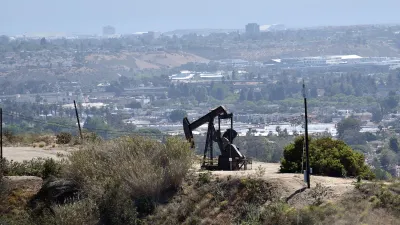For years, the Watts Towers have suffered from problems small and large: bits of decorative glass and pottery falling to the ground; cracks snaking their way through the structures and growing longer over time. A new effort aims for lasting fixes.
The Watts Towers, 17 interconnected sculptures completed by Los Angeles construction worker and artist Simon Rodia in 1954, were once the subject of a city demolition order, but are now an important cultural landmark in a struggling neighborhood.
Two years ago, Los Angeles’ Department of Cultural Affairs hired the Los Angeles County Museum of Art to maintain the sculptures. Last December, UCLA engineers joined the repair team to perform a series of structural tests.
The information gleaned from an extensive study of the Watts Towers, those involved hope, may inform preservation efforts elsewhere, reports . Thanks to sensors planted on the sculptures, the UCLA team was able to verify that the towers are in constant motion, shifting with the wind and even with the time of day. This flexibility kept the Watts Towers standing during the 1994 earthquake. It also means that repairs to the structures must bear movement in mind.
“My diagnosis of the past failures is that they repaired the cracks with a very rigid material,” Frank Preusser, a conservation scientist for LACMA said. “And they used five or six materials, but they were all rigid because they were only thinking about corrosion.”
As for the relevance of the Watts Towers research to other projects, Preusser added, “We are possibly breaking ground here. There are a number of similar structures, but not that tall. They all pose the same problems, and interestingly enough, all of them are looking at us now.”
FULL STORY: Engineers, conservationists work on lasting fix for Watts Towers

Study: Maui’s Plan to Convert Vacation Rentals to Long-Term Housing Could Cause Nearly $1 Billion Economic Loss
The plan would reduce visitor accommodation by 25,% resulting in 1,900 jobs lost.

Placekeeping: Setting a New Precedent for City Planners
How a preservation-based approach to redevelopment and urban design can prevent displacement and honor legacy communities.

Using Old Oil and Gas Wells for Green Energy Storage
Penn State researchers have found that repurposing abandoned oil and gas wells for geothermal-assisted compressed-air energy storage can boost efficiency, reduce environmental risks, and support clean energy and job transitions.

Homeowners Blame PG&E for Delays in ADU Permits
The utility says it has dramatically reduced its backlog, but applicants say they still face months-long delays for approvals for new electrical work.

Rethinking Wildfire Defense: How a Landscape Approach Can Protect Neighborhoods
Post-fire analysis of the Eaton Fire reveals that a landscape approach — including fire-resistant vegetation, home hardening, and strategic planning — can help reduce wildfire risk, challenging assumptions that trees and plants are primary fire hazards.

Scientists Studying Artificial Reefs as Flood Mitigation in Great Lakes
Artificial reefs could offer a ‘softer’ flood management and erosion solution that doesn’t disrupt the flow of sediment.
Urban Design for Planners 1: Software Tools
This six-course series explores essential urban design concepts using open source software and equips planners with the tools they need to participate fully in the urban design process.
Planning for Universal Design
Learn the tools for implementing Universal Design in planning regulations.
Borough of Carlisle
Caltrans
Heyer Gruel & Associates PA
Institute for Housing and Urban Development Studies (IHS)
City of Grandview
Harvard GSD Executive Education
Salt Lake City
NYU Wagner Graduate School of Public Service
City of Cambridge, Maryland




























